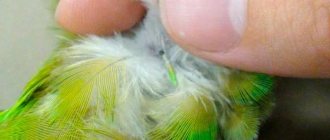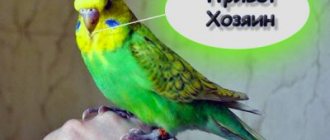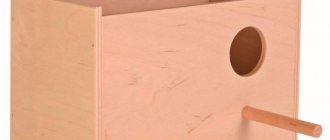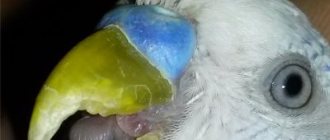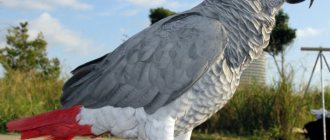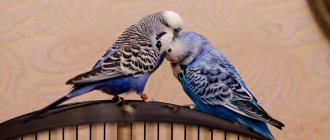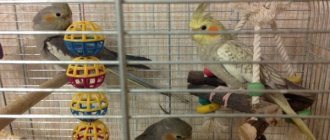When wanting to have a pet, many people prefer ornamental birds. The most common species of birds living at home are parrots. Cheerful and cheerful birds bring a lot of pleasure during communication. Developed intelligence allows you to remember a person’s words and compose them into sentences. Parrots do not require special care or living conditions, but still certain rules must be followed to maintain the health of your feathered friend. Very often, owners notice that the parrot has caught a cold. This means there were errors in the content. It is necessary to urgently begin recovery therapy, otherwise the bird may die.
Main causes of colds
Before getting a parrot, you should carefully read the rules for installing a cage in an apartment. This is an important aspect, since the bird, after moving from the nursery, can not only become very stressed, but also get sick. Not only the location is selected, but also the height of the enclosure. It is best for the cage to be at eye level for a person at full height. This is necessary so that the bird does not feel threatened by people passing by if the enclosure is lower. You should also not set it higher, otherwise the pet will not become tame and friendly. He will feel out of reach. It is very important to pay attention to the temperature in the room. Optimal conditions for birds are up to +24 degrees in summer, in winter the minimum is up to +18. In this case, the humidity in the room should be approximately 60%. In such conditions, the parrot will feel as comfortable as at home. Failure to comply with the basic rules leads to various diseases of the ward, including colds. Among the most common causes of colds in a parrot are the following factors:
- Draft. Many owners install an aviary on the windowsill. In this case, during ventilation, birds very often get colds. Drafts must be strictly excluded, not only in winter, but also in summer. Hot air in a draft can also cause illness;
- Temperatures drop below minimum levels. In winter, birds cope with lower thermometer readings. The minimum levels are considered to be +17 - +18 degrees. If the air temperature drops below, the bird will begin to freeze. In this case, the bird will constantly sit with its tufted body to keep warm. In this case, a cold cannot be avoided; hypothermia of the small organism occurs rapidly;
- Cold water in the drinking bowl. A parrot can get sick when drinking cold water. You should not let your pet drink water taken from the refrigerator. Drinking liquid should be at room temperature. If necessary, drink should be heated. After drinking cold water, the bird may become hoarse, and the inflammatory process of the respiratory system will begin. To maintain the health of the bird, it is necessary to monitor the temperature of the drink offered;
- Swimming in cold water. Parrots love to frolic in baths. To do this, each owner must acquire special bathing equipment. They come in different varieties, some are installed directly into the cage, others work from the network to create a small fountain. But during the procedure, special attention must be paid to the water temperature. The liquid should be at room temperature in summer, and in winter similar to the bird’s body temperature. If these conditions are not met, then you can soon detect cold symptoms in your parrot.
A budgie has a cold
An attentive owner will always notice the presence of the first signs of a cold in a budgie by its behavior: a bird that has a cold is inactive, sleepy, ruffled, often sneezes (there may be nasal discharge), often scratches the wax or eyes, trembles, and may refuse to drink or eat.
The mucous membrane of the nose and oral cavity is inflamed red, the bird may swallow frequently, breathe heavily (visible by moving the tail in time with breathing), and regurgitation of wet grain may be observed due to irritation of the inflamed mucosa.
Due to the structural features of the respiratory system, birds are very sensitive to drafts, sudden changes in temperature (the average room temperature should be 22-25 degrees and not fall below 20), cold water in a drinking bowl or bathing basin, which are common causes of colds. .
Sick birds lose heat very quickly. At the same time, the bird trembles all over and should be warmed. To do this, place a regular 60-watt table lamp (preferably a red one, if available) at a distance of 20-30 cm above the place where the bird usually sits. Be sure to darken half of the cage with thick fabric so that the bird has the opportunity to go into the shade if it gets hot (overheating is undesirable, as it has its consequences). You can heat for 3-5 hours a day (depending on the bird’s reaction to the lamp), dosing the heat by turning on the lamp for an hour.
An infusion of chamomile is poured into the drinking bowl; you can add a drop of lemon and honey - this will help maintain strength.
For a severe cold (with cough, severe sneezing, nasal discharge and heavy breathing), inhalations are given. To do this, use chamomile, menthol oil, eucalyptus or regular “Star” balm. 1 tbsp. chamomiles are poured with a glass of boiling water; 0.5 ml of oils are added to a 100 ml bowl and filled 2/3 with boiling water; placed next to the cage and covered all together loosely with thick cloth. The “Star” balm in the form of a pencil can simply be placed between the bars of the cage next to the bird. Inhalations are carried out 1-2 times a day for 15-30 minutes over a course of 4-5 days. Be sure to watch the bird during inhalations: if you see that your pet is breathing heavily, has its wings spread wide and its eyes half-closed, reduce the inhalation time and open the fabric covering the cage a little more.
In any case, these procedures are carried out as first aid for the bird, and in the future you should consult a doctor. There are two good reasons for this: 1) in addition to a cold, a number of the above signs of ill health may also relate to other diseases (for example, the presence of parasites or another infection), 2) an advanced local cold is dangerous because it spreads to the entire body, and therefore has complications up to the death of the bird .
Main symptoms of a cold
When a feathered friend gets sick, you can detect characteristic signs of the disease, these include the following factors:
- the bird sits on a perch, ruffled;
- does not react to the environment;
- there is poor appetite and refusal of water;
- secretion from the nasal passages is recorded;
- the cere and beak are covered with a white coating of secretory fluid;
- the parrot sneezes and coughs;
- in severe cases, the disease spreads to the lungs, inflammation begins, the bird breathes heavily and, to facilitate breathing, spreads its wings in the eagle pose, the tail twitches in time with the breathing, whistles and wheezing are heard (if you lean the bird’s chest against your ear).
Important!
Cold symptoms in a parrot develop very quickly due to the bird's accelerated metabolism. Therefore, it is necessary to immediately take action when the first signs are detected. In severe cases, consult a veterinarian.
Common diseases
If your parrot suddenly gets sick, you should be wary. Some diseases can go away on their own, but most can become severe and cause complications. Therefore, the owner must have an idea of what diseases can occur in birds and how to treat budgies.
We recommend reading: What to do if your budgie starts sneezing
Cold
It is important to remember that budgies have increased sensitivity to sudden changes in temperature, so even a draft can cause the development of a cold. For this reason, carefully monitor the vents and windows; they must be closed.
How can you determine that a parrot is sick? It is worth carefully examining his appearance; he will look unhealthy and inactive. The bird may sit in one place for a long time, and mucus may be released from its eyes and nose.
If your budgie has a cold, it will exhibit the following symptoms:
- Lethargy;
- Apathy;
- He may sneeze;
- Poor appetite;
- He sleeps constantly;
- The plumage becomes ruffled.
Before starting treatment, the bird must be taken to see a veterinarian. The specialist will conduct the necessary examination and determine the presence of a cold. Based on the data obtained, he will be able to select the appropriate treatment therapy.
At home, you can warm up your feathered pet using a lamp. Additionally, you can perform inhalations using tea tree oil. To improve the condition and speed up recovery, you can add chamomile decoction to the drinking bowl.
Ticks
When studying diseases of parrots, it is worth paying attention to ticks. Parasites often affect birds, they can come from anywhere - from other pets, the owner can bring them on clothes from the street.
When they appear, the bird begins to constantly itch. She experiences severe itching, which bothers her and causes discomfort. When these manifestations appear, it is worth moving the plumage apart; ticks can be found between the feathers. They can also be observed on the paws, near the eyes and beak.
It is important to remember that mites cause serious harm to the health of birds; they can cause the formation of growths on the surface of the paws or beak. Vaseline or vegetable oil works well; it will block the air and the pests will not be able to breathe, as a result they will die. For treatments, you can use aversectin or novertin ointment.
Goiter inflammation
Every owner of feathered pets should remember that many diseases of budgies can occur without any symptoms, so they can be ignored. Goiter inflammation is one of them. This pathological process cannot be detected at the initial stage, so it often develops into a complicated form.
The following factors may cause:
- Various toxic substances that birds can inhale;
- Consumption of low quality feed mixtures;
- Deficiency of useful elements;
- Using dirty water;
- Various complications after infectious diseases.
It is important to first study the symptoms and treatment features of budgerigar disease. Usually, when the goiter is inflamed, the bird does not eat food, it is lethargic, and practically does not drink. Over time, she begins to vomit, which may contain mucus.
Poisoning
Poisoning is a common ailment of birds. They can occur when consuming low-quality feed mixtures and unpurified water. These diseases in budgies can occur due to improper nutrition.
How can you tell if your parrot is sick? The main symptoms of poisoning include:
- The appearance of liquid droppings;
- Severe lethargy;
- Frequent vomiting;
- Poor appetite;
- Drowsiness.
In case of poisoning, the parrot should be given an absorbent. Smecta and Polysorb have a good effect. They are infused into the bird using a syringe. Dairy-free cereals are suitable for feeding. Additionally, it is worth warming your pet; a table lamp is suitable for this.
Paw injuries
Diseases of parrots can be associated with paws, namely with injuries to the limbs. They may experience dislocations, fractures, bruises, and sprains.
If a sick parrot experiences a deterioration in its condition, it is definitely worth taking it to see a veterinarian. He needs to be taken to a specialist urgently if the damaged paw is immobilized, red and swollen. The hospital will perform the necessary examination and select the appropriate treatment.
Vomiting, diarrhea and constipation
The occurrence of vomiting, diarrhea or constipation often occurs in a budgerigar with a poisonous disease. When poisoned, the bird begins to burp frequently after eating food. This may result from the following:
- When overfeeding birds;
- Insufficient supply of useful elements;
- Wrong diet;
- Liver problems;
- Peritonitis;
- Presence of parasitic organisms;
- Toxin poisoning.
Many infections in budgies are accompanied by vomiting and diarrhea. All this quickly leads to dehydration of the bird and subsequent death. In these cases, you should immediately contact a veterinarian; he will be able to save your feathered pet and prescribe effective treatment.
Lipoma
A lipoma is a tumor formation on the abdomen of a bird. It is located in the lower part of the abdomen, but can sometimes occur on other parts of the body. The tumor is benign. You may feel a ball moving under your skin.
If a budgie gets sick with this pathological process, then many owners may have a question - what to do in this situation? How can I help him? You can’t do anything on your own, otherwise you could harm your pet. It is important to visit a veterinarian immediately.
Treatment of this disease in budgies is accompanied by a special diet that is aimed at reducing weight. Lipoma is caused by obesity. The menu should include more cereals, vegetables and herbs. Also, periodically, the pet should be allowed out of the cage to fly.
We recommend reading: How many years do budgies live?
Inflammation of the cloaca
When studying what ailments parrots have, it is worth paying attention to inflammation of the cloaca. This disease develops as a result of poor nutrition, lack of vitamins, and also when the bird eats difficult-to-digest food. Inflammation can develop due to poor quality cleaning of the feathered pet’s cage.
The following symptoms of the disease are observed in a budgerigar:
- Diarrhea;
- Gluing and clumping of feathers around the cloaca;
- Inflammation of the skin near the cloaca, signs of swelling;
- Significant weight loss;
- Lack of appetite;
- Decreased activity;
- The appearance of blood and mucous discharge.
If symptoms occur, you should contact your veterinarian. Only a doctor can conduct a quality examination and prescribe the necessary examination.
Treatment methods
If a parrot has a cold, then it is necessary to carry out the warming procedure from the first days. To do this, install a 60 W lamp near the cage and turn it on for 10 - 15 minutes. During the procedure, you need to monitor your pet's breathing. If deterioration is noted, stop heating immediately. Inhalations are done. A container of water is placed near the enclosure with eucalyptus or menthol poured into it. The procedure also lasts 15 minutes twice a day. Antibiotics are prescribed. The best remedy would be Ciprofloxacin. To do this, 1/8 of a 500 mg tablet is ground and mixed with 1 ml of water. Using a syringe. Three drops of medicine are poured into the bird’s beak twice a day. The course of treatment is 5 days. If it is not possible to carry out therapy on your own, then it is better to contact an ornithologist. Proper therapy eliminates complications and death of your beloved pet.
Treatment
Now let's talk about treatment.
First of all, make sure that the room temperature corresponds to normal conditions and does not fall below 22 degrees.
If there are several birds in a cage, the sick bird should be placed in a separate cage from the healthy ones. If all the birds are sick or you have only one parrot, then there is no need to remove them.
Lamp
A sick bird needs to turn on an incandescent lamp. There is no need to use energy-saving, diode or other lamps. The lamp power should be 60 watts. The incandescent lamp must be installed above the cage at a distance of 35-45 cm. If the lamp is more powerful, then it must be installed higher. One half of the cage is covered with thick dark cloth.
When the parrot warms itself, it will go into the shade. The lamp must be turned off and turned on after 2-3 hours. If the wavy does not want to warm up, turn off the lamp. This procedure must be repeated 3-5 times a day.
One heating period should not exceed one hour. In just one day, a parrot can bask for 3-5 hours in total. Overheating is highly undesirable.
Medicines
During a cold, a solution of chamomile is poured into the drinking bowl. Change the solution 2-3 times a day.
Honey and lemon. Budgerigars
You can also add honey and (or) lemon juice to the chamomile solution. Dosage: 3 drops of honey and lemon juice per 50 ml.
Inhalations
For severe colds with frequent coughing, profuse nasal discharge and constant sneezing, it is necessary to perform steam inhalation procedures.
Menthol oil
For inhalation you can use:
- menthol oil: 0.5 ml per 100 ml of boiling water;
- eucalyptus oil: 0.5 ml per 100 ml of boiling water;
- chamomile decoction: 1 tbsp. chamomile to 250 ml of boiling water;
- Eucalyptus decoction: 1 tbsp. chamomile per 300 ml of boiling water;
- sage decoction: 1 tbsp. chamomile to 300 ml of boiling water.
The container with the solution is placed next to the cage. I cover the cage and container with a towel. During the procedure, watch your pet: if it is noticeable that he is breathing heavily, spreading his wings, closing his eyes, then reduce the procedure time and open the fabric slightly.
Menthol oil
Steam inhalations are carried out in a course of 1 or 2 times a day for 15-25 minutes for 4-5 days.
In case of severe shortness of breath, sniffling or whistling, inhalation is prohibited! Possible pulmonary edema.

